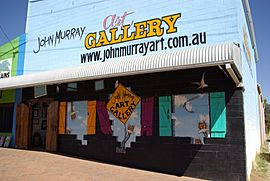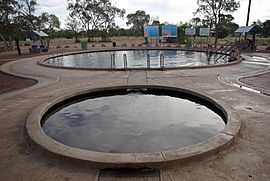Lightning Ridge, New South Wales facts for kids
Quick facts for kids Lightning RidgeNew South Wales |
|||||||||
|---|---|---|---|---|---|---|---|---|---|

Fossicking field in Lightning Ridge
|
|||||||||
| Population | 2,284 (2016 census) | ||||||||
| Established | 1922 | ||||||||
| Postcode(s) | 2834 | ||||||||
| Elevation | 170 m (558 ft) | ||||||||
| Location | |||||||||
| LGA(s) | Walgett Shire | ||||||||
| County | Finch | ||||||||
| State electorate(s) | Barwon | ||||||||
| Federal Division(s) | Parkes | ||||||||
|
|||||||||
Lightning Ridge is a small town in the Australian Outback. It is located in north-western New South Wales, close to the border of Queensland. This town is famous for its unique black opal and other beautiful opal gemstones. People come from all over the world to search for these precious stones.
Contents
First Peoples of Lightning Ridge
The original owners of the land around Lightning Ridge are the Yuwaalaraay people. They have lived here for thousands of years. Their language, Yuwaalayaay, is related to other Aboriginal languages like Gamilaraay. This language was spoken across a wide area, including parts of Queensland and New South Wales.
In the early 1900s, many Yuwaalaraay people were forced to leave their homes. They had to move to other settlements, like Brewarrina, even though they had lived on this land for a very long time.
How Lightning Ridge Got Its Name
European settlers arrived in the mid-1800s. They first used the land for pastoral activities, which means raising sheep or cattle.
The town's name, Lightning Ridge, comes from a sad story from the 1870s. It is said that a farmer, his dog, and 200 sheep were all struck by lightning and died there. That's how the place got its unusual name.
Europeans did not know about the opal here until the late 1800s. In 1905, the first mining shafts were dug. The special black opal quickly became famous. Miners from other towns, like White Cliffs, came to find it.
A very important person in the history of black opal was Charlie Nettleton. He walked a long way, about 700 kilometres (435 miles), from White Cliffs just to see the black opal. He later helped create a market for these unique stones. Charlie Nettleton is now known as the founder of the black opal industry. There is a bronze statue of him in town called "Spirit of Lightning Ridge."
Who Lives in Lightning Ridge?
The number of people living in Lightning Ridge changes a lot. This is because many miners move in and out of town.
In 2001, about 1,826 people lived there. By 2016, the population was 2,284. The average age of people in Lightning Ridge was 51 years old.
- About 22.7% of the people were Aboriginal and Torres Strait Islander.
- Most people (around 69.2%) were born in Australia.
- Other people came from countries like England, Germany, and the Philippines.
- About 79.1% of people spoke only English at home. Some other languages spoken included Serbian and German.
Weather in Lightning Ridge
Lightning Ridge has a hot, dry climate. It gets very hot in summer and has mild winters.
| Climate data for Lightning Ridge | |||||||||||||
|---|---|---|---|---|---|---|---|---|---|---|---|---|---|
| Month | Jan | Feb | Mar | Apr | May | Jun | Jul | Aug | Sep | Oct | Nov | Dec | Year |
| Record high °C (°F) | 48.5 (119.3) |
47.2 (117.0) |
42.0 (107.6) |
36.1 (97.0) |
32.0 (89.6) |
27.2 (81.0) |
28.8 (83.8) |
36.2 (97.2) |
39.3 (102.7) |
41.5 (106.7) |
44.5 (112.1) |
43.6 (110.5) |
48.5 (119.3) |
| Mean daily maximum °C (°F) | 36.1 (97.0) |
34.9 (94.8) |
32.4 (90.3) |
28.1 (82.6) |
23.2 (73.8) |
19.4 (66.9) |
19.3 (66.7) |
21.6 (70.9) |
26.2 (79.2) |
29.4 (84.9) |
31.9 (89.4) |
34.6 (94.3) |
28.1 (82.6) |
| Mean daily minimum °C (°F) | 22.5 (72.5) |
21.7 (71.1) |
19.0 (66.2) |
14.4 (57.9) |
9.1 (48.4) |
6.6 (43.9) |
4.9 (40.8) |
6.1 (43.0) |
10.4 (50.7) |
14.2 (57.6) |
18.2 (64.8) |
20.2 (68.4) |
13.9 (57.0) |
| Record low °C (°F) | 11.5 (52.7) |
10.3 (50.5) |
5.0 (41.0) |
2.0 (35.6) |
0.0 (32.0) |
−3.5 (25.7) |
−4.4 (24.1) |
−2.2 (28.0) |
1.5 (34.7) |
4.9 (40.8) |
6.0 (42.8) |
5.0 (41.0) |
−4.4 (24.1) |
| Average precipitation mm (inches) | 50.6 (1.99) |
40.0 (1.57) |
40.7 (1.60) |
27.6 (1.09) |
25.0 (0.98) |
47.3 (1.86) |
30.2 (1.19) |
18.2 (0.72) |
30.6 (1.20) |
40.3 (1.59) |
55.5 (2.19) |
59.5 (2.34) |
478.2 (18.83) |
| Average precipitation days | 5.8 | 4.5 | 5.3 | 3.4 | 4.0 | 5.5 | 4.9 | 4.0 | 4.3 | 5.5 | 7.1 | 7.2 | 61.5 |
| Average afternoon relative humidity (%) | 35 | 38 | 38 | 41 | 44 | 54 | 48 | 38 | 33 | 34 | 39 | 33 | 40 |
Fun Things to Do
Lightning Ridge has many fun activities. The Lightning Ridge Opal and Gem Festival happens every year. The town also has a great Olympic-sized swimming pool. It includes a diving area, a rock climbing wall, and a water park that opens in summer. There are also barbecue areas for families to enjoy.
The Ella Nagy Youth Centre opened in 2000 and has a cool skatepark. For many years, Lightning Ridge also hosted an annual goat race right on the main street! Kids would drive the goats, similar to horse racing. There were also wheelie-bin races and horse races.
The local football team is called the Lightning Ridge Redbacks. They play in the Group 15 Barwon Darling Rugby League competition.
Lightning Ridge is also home to the St George Serbian Orthodox Church. A priest visits several times a year to hold church services.
Local Artists
Many artists live in and around Lightning Ridge. One famous Australian painter is John Murray. His paintings show the beauty of the Outback, often with people or animals.
Ancient Fossils
Lightning Ridge is a very important place for finding fossils. These opalised fossils are about 100 million years old, from the Cretaceous period. This was a time when dinosaurs ruled the Earth!
The site is special because it has fossils of ancient mammals. These mammals were small creatures living alongside the huge dinosaurs. Opal miners sometimes find these amazing fossils. Some important discoveries include early monotremes (mammals that lay eggs) like Kollikodon ritchiei and Steropodon galmani.
In 2019, a new type of dinosaur was found here. It was named Fostoria dhimbangunmal. This plant-eating dinosaur lived at least 100 million years ago. It is the most complete dinosaur fossil ever found that is preserved as opal!
Searching for Opals (Fossicking)
If you want to search for opals, it's called fossicking. Since 1992, you don't need a special license to fossick in New South Wales.
However, you still need to follow some rules:
- Make sure no other laws stop you from fossicking.
- You must get permission from the landowner.
- If the land is managed by a public group, you need their permission too.
- If someone already has a mining permit for the area, you need their permission as well.
Hot Water Springs
Lightning Ridge has lots of hot water from a natural spring. This water comes from the Great Artesian Basin, a huge underground water source. The town has two hot-water pools where people can bathe. You can even get mineral water from a hose in Harlequin Street. The Hot Artesian Bore Baths are a famous spot in Lightning Ridge.
Media and News
The town has three radio stations: Opal FM (89.7 MHz), Outback Radio 2WEB (90.5 MHz), and 2CUZ FM (96.1 MHz).
The Western Herald is a newspaper published every Thursday. It covers local stories from Lightning Ridge.
Famous People from Lightning Ridge
- Australian comedian and actor Paul Hogan (famous for Crocodile Dundee) once said he was from Lightning Ridge. He did this to help his chances on a TV show. Even though he was actually born in Sydney, this story helped bring tourists to Lightning Ridge!
- Tyrone Lindqvist, a member of the band Rüfüs Du Sol, grew up in Lightning Ridge.
- Bella McKenzie, who plays for the Australian women's rugby union team, is truly from Lightning Ridge.
Gallery








